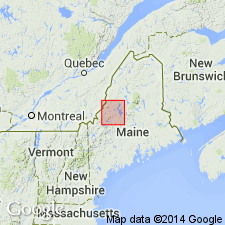
- Usage in publication:
-
- Big Claw red-bed member*
- Modifications:
-
- Named
- Dominant lithology:
-
- Quartzite
- Sandstone
- Slate
- Conglomerate
- AAPG geologic province:
-
- New England province
Summary:
Pg.159, 178-180, pl. 34. Big Claw red-bed member of Lobster Lake formation. Consists of red quartzite, red sandstone, red slate, and red conglomerate, with small amount of gray sandstone. Red color is due to finely dispersed hematite; medium-sized particles are scattered throughout. Thickness 200 feet. Comprises lower part of formation. Unconformably overlies reddish phyllite of Cambrian or Ordovician age. Is nonfossiliferous. Age is Silurian, based on stratigraphic position. Report includes geologic map and correlation chart.
Type locality: on east side of Big Claw arm [east] of northern part of Big Island [approx. Lat. 45 deg. 52 min. 00 sec. N., Long. 69 deg. 30 min. 25 sec. W., Lobster Mountain 7.5-min quadrangle]. Extends southwestward in narrow belt about 5 mi long; exposed on east- and west-central shores of Lobster Lake. Named for Big Claw arm of Lobster Lake, southwest quarter of Ragged Lake 15-min quadrangle [Lobster Mountain Mountain 7.5-min quadrangle] and southeast quarter of North East Carry 15-min quadrangle [Big Spencer Mountain 7.5-min quadrangle], western Piscataquis Co., west-central ME.
Source: Publication; US geologic names lexicon (USGS Bull. 1350, p. 65); GNU records (USGS DDS-6; Reston GNULEX).
For more information, please contact Nancy Stamm, Geologic Names Committee Secretary.
Asterisk (*) indicates published by U.S. Geological Survey authors.
"No current usage" (†) implies that a name has been abandoned or has fallen into disuse. Former usage and, if known, replacement name given in parentheses ( ).
Slash (/) indicates name conflicts with nomenclatural guidelines (CSN, 1933; ACSN, 1961, 1970; NACSN, 1983, 2005, 2021). May be explained within brackets ([ ]).

